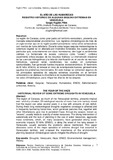| dc.rights.license | http://creativecommons.org/licenses/by-nc-sa/3.0/ve/ | |
| dc.contributor.author | Foghin Pillin, Sergio | |
| dc.date.accessioned | 2016-07-25T16:52:26Z | |
| dc.date.available | 2016-07-25T16:52:26Z | |
| dc.date.issued | 2015-07 | |
| dc.identifier.issn | 2244-7008 | |
| dc.identifier.uri | http://www.saber.ula.ve/handle/123456789/42188 | |
| dc.description.abstract | La región de Caracas, como gran parte del territorio venezolano, presenta una marcada estacionalidad pluviométrica. Los registros climatológicos de más de un siglo revelan que en la región pueden presentarse varios años consecutivos con montos de lluvia deficitario. Durante estas largas sequías meteorológicas la cobertura vegetal se ve afectada por incendios forestales, los cuales generan partículas que, conjuntamente con otros litometeoros, dan lugar a persistentes calimas. La temporada de sequía, conocida como “verano”, conlleva usualmente crítica escasez de los recursos hídricos. La intervención irracional de las cuencas hidrográficas y la falta de planificación en el uso de los recursos hidráulicos, agravan estas condiciones, las cuales, en numerosas oportunidades, han generado fuertes impactos socioeconómicos. El fenómeno de El Niño (ENOS), al retrasar el inicio de la temporada lluviosa, generalmente agudiza los problemas mencionados. En este trabajo se comentan algunos de los principales episodios de sequías extremas ocurridos en el territorio venezolano y se destaca la importancia de la planificación ambiental basada en los datos climatológicos, para mitigar los efectos de las sequías. | es_VE |
| dc.rights | info:eu-repo/semantics/openAccess | |
| dc.subject | Sequías | es_VE |
| dc.subject | Venezuela | es_VE |
| dc.subject | Humaredas | es_VE |
| dc.subject | ENOS | es_VE |
| dc.subject | Administración ambiental | es_VE |
| dc.subject | Historia | es_VE |
| dc.title | El año de las humaredas registro histórico de algunas sequías extremas en Venezuela. | es_VE |
| dc.title.alternative | The year of the haze historical review of some extreme droughts in Venezuela. | es_VE |
| dc.type | info:eu-repo/semantics/article | |
| dc.description.abstract1 | The region of Caracas, as much of the Venezuelan territory, presents tropical wet- -and-dry climates. Climatological records of more than one century reveal that the region can arise several years in a row with amounts of rain deficit. During these long meteorological droughts vegetative coverage is affected and is frequently burned by forest fires, which generate particles that, together with other lithometeors, give rise to persistent haze. Annual dry season, known as "verano", usually leads to scarcity of water resources. The strong intervention of watersheds and the lack of planning in the use of water resources, aggravate these conditions, which, on many occasions, have generated strong socio-economic impacts. El Niño (ENSO), to delay the onset of the rainy season in Venezuela, usually worsens the problems above mentioned. This paper discusses some of the major episodes of extreme drought that occurred in Venezuelan territory, and stressed the importance of the environmental planning based on climatological data to mitigate the effects of drought. | es_VE |
| dc.description.colacion | 3 - 25 | es_VE |
| dc.description.email | sfoghin@hotmail.com | es_VE |
| dc.description.frecuencia | Semestral | |
| dc.identifier.depositolegal | PPI200302ME3529 | |
| dc.publisher.pais | Venezuela | es_VE |
| dc.subject.institucion | Universidad de Los Andes (ULA) | es_VE |
| dc.subject.keywords | Droughts | es_VE |
| dc.subject.keywords | Venezuela | es_VE |
| dc.subject.keywords | Haze | es_VE |
| dc.subject.keywords | ENSO | es_VE |
| dc.subject.keywords | Environmental management | es_VE |
| dc.subject.keywords | History | es_VE |
| dc.subject.publicacionelectronica | Revista Bitácora-e | |
| dc.subject.seccion | Revista Bitácora-e: Artículos | es_VE |
| dc.subject.thematiccategory | Artes y Humanidades | es_VE |
| dc.subject.tipo | Revistas | es_VE |
| dc.subject.unidadinv | Grupo Venezolano de Historia y Sociología de la Ciencia (GVHSC) | es_VE |
| dc.type.media | Texto | es_VE |


